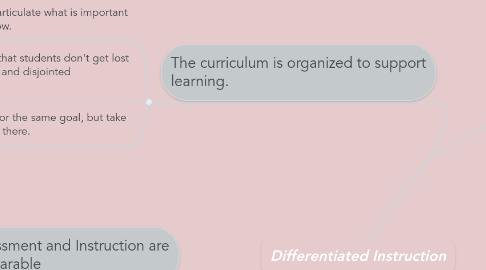Differentiated Instruction
by Blake Berry


1. Assessment and Instruction are Inseparable
1.1. Assessment is done often and daily to ensure students are grasping material rather than just at the end of a unit.
1.2. Assessment is done in many different formats in order to fairly assess different students who may be at different stages in learning.
1.3. Assessment may need to be different based on students learning abilities and progress in class.
2. The curriculum is organized to support learning.
2.1. Teachers need to articulate what is important for students to know.
2.2. Clarity insures that students don't get lost in unimportant and disjointed information.
2.3. Each student strives for the same goal, but take different roads to get there.
3. The teacher modifies content, process ,and products based on student readiness, interest, and learning profile
3.1. Teacher Factors
3.1.1. Content- What you want students to learn
3.1.2. Process- Activities designed to teach content
3.1.3. Products- vehicles through which students demonstrate their knowledge
3.2. Student Factors
3.2.1. Readiness- Student's entry point to particular knowledge
3.2.2. Interest- Learner's affinity/passion for a topic/skill
3.2.3. Learning Profile- The ways in which a learner learns

